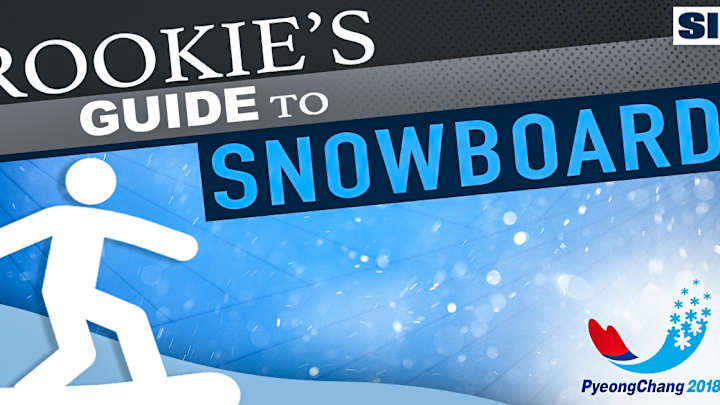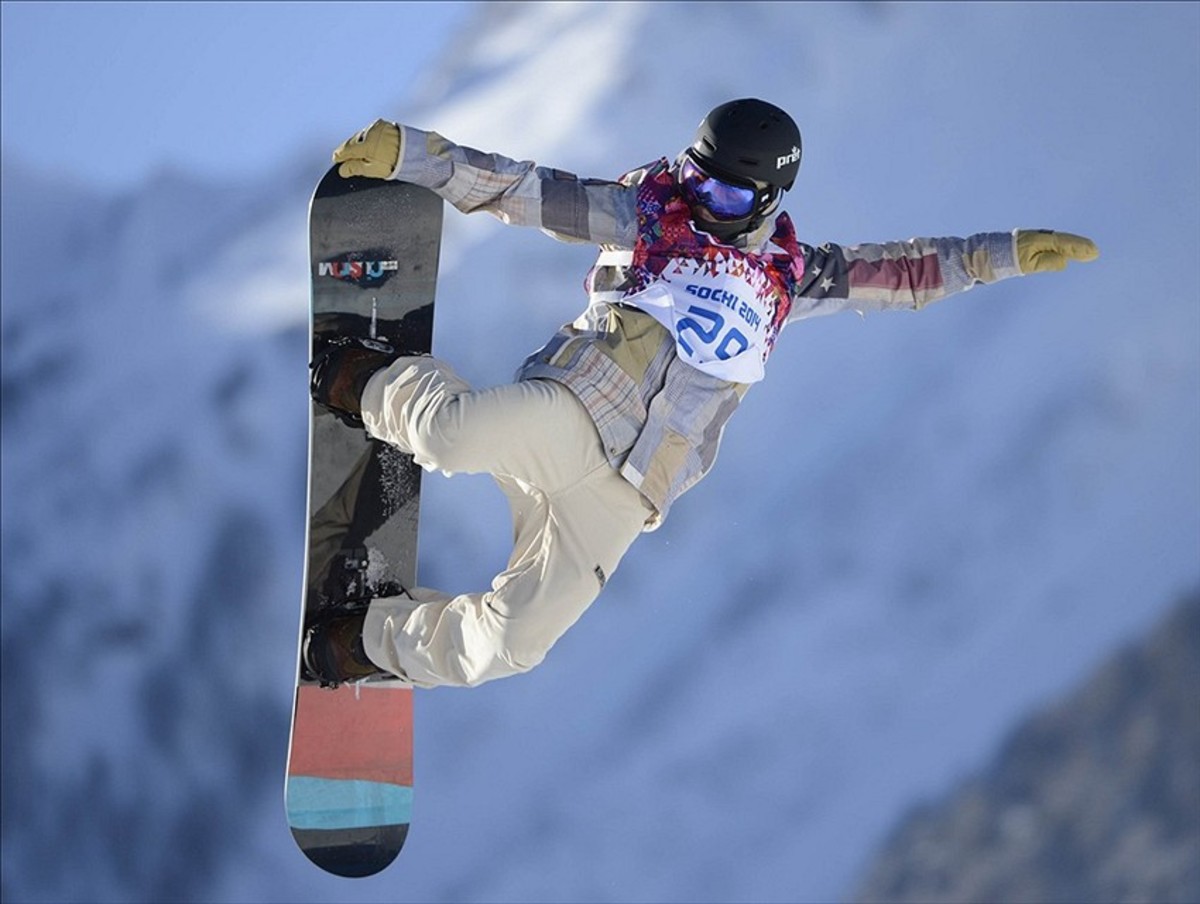A Rookie's Guide to Snowboard at the 2018 Winter Olympics

The 2018 Winter Olympics in PyeongChang, South Korea are right around the corner! That means it's time to watch sports you might not have seen in four years. To help you feel at least a little more informed—either to impress your friends or fake your way through a conversation with an actual expert—SI will be providing rookie's guides to each of the 15 sports. These will be published daily, Monday through Friday, from December 4-22.
Although a popular sport today, snowboard is fairly new to the Winter Olympics. Out of the five new sports added to the Olympic program between 1992 and 2002, snowboard was the only one not to have been a previous medal or demonstration event.
At the 1998 Games, snowboard was introduced through two events: the giant slalom and the half-pipe. Canadian Ross Rebagliati won the men's giant slalom to become the first athlete to win a gold medal in snowboard.
Today, a total of ten snowboard events are held, in which 258 athletes participate.
Here's everything you need to know about one of the most exciting and physically demanding events at the Games.
So, what is snowboarding?
Most people are familiar with snowboarding, either as a recreational activity or a sport where individuals descend a snow-covered slope while standing on a board attached to the rider's feet. Think skateboarding, skiing, surfing and sledding all mixed into one, action-packed sport.
If this 1-year old can do it, I think it's safe to say that anyone can snowboard.
What is the history of the sport?
Snowboarding has a relatively short history. As mentioned earlier, it wasn't introduced as a Winter Olympic sport until 1998 and was only featured in the Winter Paralympics at the 2014 Games in Sochi.
While we cannot confirm the origin of the sport, it is believed to first be contested in 1968, when Sherman Poppen, an engineer in Michigan, fastened two skis together and attached a rope to one end for his children to glide downhill.
Poppen dubbed the toy as the "snurfer" and it proved so popular that he licensed the idea to a manufacturer and sold over half a million products in 1966 alone.
Over the next two decades, the sport would grow in popularity thanks to Americans Tom Sims and Jake Burton Carpenter, as well as Welsh skateboard enthusiasts Jon Roberts and Pete Matthews.
The first competitions to offer prize money were the National Snurfing Championship in Muskegon, Michigan.
What are the different events at the Olympics?
There are five different snowboard events at the Olympics, with each event having a men's and women's competition. This means 30 total medals and 10 golds in PyeongChang.
Halfpipe:
What is it?: Halfpipe is an event where athletes perform jumps, rotations and twists in the air as they glide criss-crossing a semi-circular ramp.
Format: Halfpipe consists of a qualification and final round. 30 riders will compete in the men's competition and 24 riders will compete in the women's competition. The qualification will consist of two runs and each competitor's best single run will count toward advancement. The top 12 riders will advance to the final round, where each athlete will perform three runs and use their best run to determine the medalists.
Judging: Athletes are judged based on the amplitude (height), difficulty, variety and execution of their runs. In terms of amplitude, judges will reward athletes who maintain a good amplitude throughout their run. They will also assess the technical difficulty of the tricks performed. Tricks with more rotation or inverts are considered more difficult and will be rewarded appropriately. Furthermore, judges expect riders to showcase a variety of tricks. Finally, the stability, fluidity and control of the tricks will play into the execution category.
Snowboard Cross:
What is it?: Snowboard Cross involves heats of four to six athletes racing down a course organized with various terrain structures such as banks, rollers, spines and jumps. It's a race: The finish is decided by the order they cross the finish line.
Format: The event consists of two portions: seeding/qualification and elimination rounds. For men, all 40 riders will take individual runs through the course to determine the seeding for the final brackets. For women, only the top 24 out of 30 riders will advance to the elimination heats. The men's eliminations will consist of eight heats of five riders and the top three racers from each heat will advance to the quarterfinals. The top three riders from each of the four quarterfinal heats will advance to the semifinal heat, where the top six will advance to the finals. The women's event begins with the quarterfinal heats and proceeds in an identical manner as the men's.
Judging: Since snowboard cross is a race, there are no judges. However, there are referees during the event who will disqualify riders for intentional contact by pushing, pulling or any other method. Furthermore, a rider is not allowed to intentionally block an opponent from passing.
Parallel Giant Slalom:
What is it?: This event requires two athletes to depart simultaneously at two courses, which are installed in parallel. The athlete who comes down faster wins.
Format: Parallel giant slalom features a qualification round and a head-to-head elimination rounds. In the qualification round, competitors will take two runs and their times are added together. The athletes with the top 16 times advance to the elimination rounds, where they are seeded and placed into a bracket. The event proceeds with a head-to-head tournament-style elimination format.
Judging: Like snowboard cross, this competition is a race and does not consist of judges scoring the event. Referees will, however, disqualify riders for false starts, disturbing their opponents during a run, passing through the wrong gate, failing to execute a turn on the outside of a gate and not finishing the run with at least one foot fixed to the board.
Big Air:
What is it?: In Big Air, competitors ride a snowboard down a hill and perform tricks after launching off large jumps.
Format: Big airis new to the Olympics in 2018 and will consist of the same format as the previous two disciplines. However, in the final, the scores from each competitor's two best runs will be added together to get the final results.
Judging: The eventis scored by six judges. Each rider's highest and lowest scores are dropped and the remaining four are averaged together to calculate the score. Judges evaluate riders based on difficulty of the tricks, execution of the run, amplitude of the techniques and landing of the jumps.
Slopestyle:
What is it?: Slopestyle is held on a course organized with rails, tables, boxes, walls and jump pads. The athletes can select the objects they want to perform with.
Format: The competition consists of a similar style as halfpipe. The qualification round consists of two runs and the top 12 riders will advance to the final. Again, the final will consist of three runs and riders will use their best score towards the final results.
Judging: Slopestyle is judged by a team of nine judges, three of which evaluate each run based on overall impression. The other six evaluate tricks done on specific sections of the course. Judges use the same criteria as halfpipe to assess riders and usually weight the score based on 60% trick scores and 40% overall impression.
How do athletes qualify?
A total of 258 quota spots are available to athletes to compete at the Games. No more than 26 athletes from each National Olympic Committee can participate
Do they wear cool uniforms?
Yes! They usually wear tights and a bib with their number and country on top. Also, they're decked out in some pretty cool shades and either a helmet or a bandana to complete the outfit.
I would argue their uniforms are the best in sports. Also, they are literally gliding through the air, so that helps make them look pretty majestic.

Why should I care about the sport?
If you like action and drama, this is the sport for you. The sheer athleticism, preparation and technique in each of the snowboard events and jumps is unbelievable. I mean just look at this.
Snowboarding is also the most accessible and practical sport at the Winter Olympics. Almost anyone can learn to snowboard and there is no better feeling than working to emulate your favorite snowboarders on the slopes.
Who are the favorites?
American superstar sensation Shaun White is a household name at the Olympics, but fell during the qualifying round of the Dew Tour and will have just two more events in January to secure his spot in the PyeongChang Games.
White, however, is the most dominant snowboarder of his generation and is widely credited for bringing the sport to it's peak level of popularity.
Internationally, Russian Vic Wild is a favorite for the men's parallel giant slalom event and American Sage Kotsenburg will look to repeat his Gold medal in Men's slopestyle.
Among the favorites for the women's group include Americans Kaitlyn Farrington (halfpipe) and Jamie Anderson (slopestyle). Internationally, the Czech Republic's Eva Samkova and France's Chloe Trespeuch are expected to compete for the snowboard cross event.
